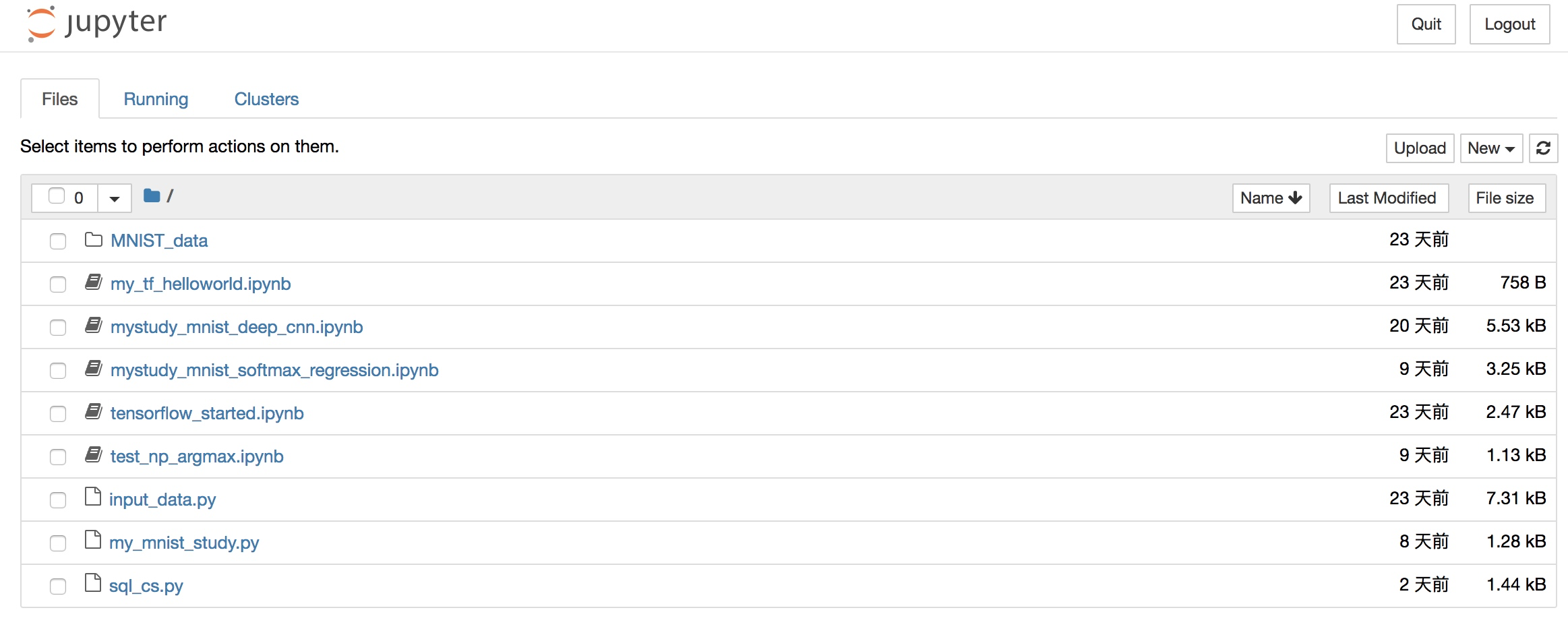演算法初探:Tensorflow及PAI平臺的使用
前言
Tensorflow這個詞由來已久,但是對它的理解一直就停留在“聽過”的層面。之前做過一個無線圖片適配問題智慧識別的專案,基於Tensorflow實現了GoogLeNet - Inception V3網路(一種包含22層的深層卷積神經網路),但是基本上也屬於“盲人摸象”、“照葫蘆畫瓢”的程度。作為當今機器學習乃至深度學習界出現頻率最高的一個詞,有必要去了解一下它到底是個什麼東西。
而PAI,作為一站式地機器學習和演算法服務平臺,它大大簡化了模型構建、模型訓練、調參、模型效能評估、服務化等一系列演算法的工作,可以幫助我們更快捷地實現演算法實驗和應用。
一、Tensorflow初探
1. 安裝和啟動
因為我自己的mac-pro安裝了docker,所以安裝Tensorflow的環境非常簡單,只要拉取Tensorflow的官方映象就可以完成Tensorflow的環境搭建。
#拉取tensorflow映象
docker pull tensorflow/tensorflow
#建立一個tensorflow的工作目錄,掛載到容器內
mkdir -p /Users/znifeng/docker-data/tensorflow/notebooks
#啟動容器
docker run -it --rm --name myts -v /Users/znifeng/docker-data/tensorflow/notebooks:/notebooks -p 8888:8888 tensorflow/tensorflow
啟動成功後,將看到如下資訊: 

複製連結http://127.0.0.1:8888/?token=487c52e0aa0cd2a7b231bf909c1d6666482f8ed03353e510到瀏覽器,就可以看到jupyter(支援線上編寫和除錯python的互動式筆記本)頁面:
 

接下來,你可以在jupyter上或者在docker容器內部編寫和除錯tensorflow的程式碼,容器內部已經包含了tensorflow的所有庫。
2. 基本使用
2.1 核心概念
- 使用圖(graph)來表示計算任務
- 使用張量(tensor)來表示資料。張量與向量的區別:向量相當於一階的張量,張量可以從0階到多階(多維)
- 圖中的每一個節點稱之為op(operation),每一個op有0或多個Tensor作為輸入,執行計算後產出0或多個Tensor作為輸出
- 在被稱之為會話Session的上下文(context)中執行圖
- 通過變數(variable)來維護狀態
- 使用feed和fetch可以為任意的操作賦值或者從其中獲取資料
- 使用placeholder來定義佔位符,在執行時傳入對應的引數值
TensorFlow程式通常被組織成一個構建階段和一個執行階段。在構建階段,op的執行步驟被描述成一個圖,在執行階段,使用會話執行圖中的op。在Python中,返回的tensor是numpy.ndarray物件。;在C/C++中,返回的是tensorflow:Tensor例項。
2.2 使用示例
2.2.1 第一個helloworld程式:
import tensorflow as tf
#第一階段: 構建圖
#定義一個1x2的矩陣,矩陣元素為[3 3]
matrix1 = tf.constant([[3., 3.]])
#定義一個2x1的矩陣,矩陣元素為[2
2]
matrix2 = tf.constant([[2.],[2.]])
# 建立一個矩陣乘法 matmul op , 把 'matrix1' 和 'matrix2' 作為輸入.
product = tf.matmul(matrix1, matrix2)
#第二階段: 執行圖
with tf.Session() as sess:
print "matrix1: %s" % sess.run(matrix1)
print "matrix2: %s" % sess.run(matrix2)
print "result type: %s" % type(sess.run(product))
print "result: %s" % sess.run(product)
輸出結果:
matrix1: [[3. 3.]]
matrix2: [[2.]
[2.]]
result type: <type 'numpy.ndarray'>
result: [[12.]]
如上圖所示,在第一階段(構建圖)中,我們的每一行操作其實都是一個operation,包含兩個constant操作和一個矩陣相乘的操作,每個operation的輸出都是tensor,它的型別是num.ndarray。實際上,構建階段我們只是定義op,並不會真正去執行;而在第二階段中,通過定義了一個會話session,我們才會在會話中真正開始執行前面定義的各個operation,然後獲得執行的結果。
2.2.2 使用tensorflow實現識別手寫數字(1~9)模型 —— Softmax Regression
import input_data
mnist = input_data.read_data_sets("MNIST_data/", one_hot=True)
import tensorflow as tf
##Define input data format
#input images, each image is represented by a tensor of 784 dimensions
x = tf.placeholder("float", [None,784])
#input labels, each label values one digit of [0,9], which is represented by a tensor of 10 dimensions
y_ = tf.placeholder("float", [None, 10])
##Define Model and algorithm
#weight array of each feature VS predicted result
W = tf.Variable(tf.zeros([784, 10]))
#bias of each digit
b = tf.Variable(tf.zeros([10]))
#predicted probability array of an image, which is of 10 dimensions.
#tf.matmul:矩陣相乘
y = tf.nn.softmax(tf.matmul(x,W) + b)
#cross-entropy or called loss function
#tf.reduce_sum:壓縮求和: tf.reduce_sum(x, 0)將x按行求和,tf.reduce_sum(x, 1)將x按列求和,tf.reduce_sum(x, [0, 1])按行列求和
cross_entropy = -tf.reduce_sum(y_*tf.log(y))
#gredient descent algorithm
train_step = tf.train.GradientDescentOptimizer(0.01).minimize(cross_entropy)
##Training model
#initialize all variables
init = tf.global_variables_initializer()
with tf.Session() as sess:
sess.run(init)
for i in range(1000):
batch_xs, batch_ys = mnist.train.next_batch(100)
sess.run(train_step, feed_dict={x: batch_xs, y_:batch_ys})
##Evaluation
#tf.argmax(vector, 1):返回的是vector中的最大值的索引號。tf.argmax(vector, 0)
correct_prediction = tf.equal(tf.argmax(y,1), tf.argmax(y_,1))
accuracy = tf.reduce_mean(tf.cast(correct_prediction, "float"))
print sess.run(accuracy, feed_dict={x: mnist.test.images, y_: mnist.test.labels})
輸出結果:
0.904
模型中使用的資料來自tensorflow/g3doc/tutorials/mnist/,總共包含7萬張784(28x28)畫素的1~9的數字圖片,其中55000張用於模型訓練作為訓練集,5000張作為驗證集,剩餘10000張用作測試集。
因此,每一張圖片都可以用一個784維的向量來表示,向量裡的每一個元素表示某個畫素的強度值,介於0和1之間。使用x = tf.placeholder("float", [None,784])表示輸入集x,其中placeholder為佔位符,在實際使用時,我們再通過feed傳入具體的行數來替換其中的None。y_則為對應的實際結果,因為結果集合為0~9,因此我們可以用[y0,y1,...,y9]的十維向量來表示結果,比如數字“1”可以表示為[0,1,0,0,0,0,0,0,0,0]。本例中,定義的模型為線性模型,先用wx+b得到初步結果z,再通過softmax函式將z折射得到0~9各個數字的概率值。
 

在模型求解時,我們需要定義一個指標來評估模型是好的。而在機器學習中,通常是定義指標來表示模型是壞的,然後儘量最小化該指標得到最優解,該指標也稱為成本(cost)或損失(loss)函式。本例中,我們用“交叉熵”來作為損失函式cross_entropy = -tf.reduce_sum(y_*tf.log(y)),然後用梯度下降的方式求解train_step = tf.train.GradientDescentOptimizer(0.01).minimize(cross_entropy)。其中0.01為下降的速率。
可以看到,經過1000次迭代,我們的模型的預測結果的準確率達到了90.4%。
2.2.3 使用tensorflow實現識別手寫數字(1~9)模型 —— DeepCNN
上節中用softmax模型預測的準確率大概在90%,接下來嘗試下用tensorflow實現一個卷積神經網路模型來識別手寫數字。
import input_data
mnist = input_data.read_data_sets("MNIST_data/", one_hot=True)
import tensorflow as tf
def weight_variable(shape):
initial = tf.truncated_normal(shape, stddev=0.1)
return tf.Variable(initial)
def bias_variable(shape):
initial = tf.constant(0.1, shape=shape)
return tf.Variable(initial)
def conv2d(x, W):
return tf.nn.conv2d(x, W, strides=[1,1,1,1], padding="SAME")
def max_pool_2x2(x):
return tf.nn.max_pool(x, ksize=[1, 2, 2, 1], strides=[1, 2, 2, 1], padding='SAME')
x = tf.placeholder("float", shape=[None, 784])
y_ = tf.placeholder("float", shape=(None, 10))
#第一層卷積
W_conv1 = weight_variable([5, 5, 1, 32])
b_conv1 = bias_variable([32])
x_image = tf.reshape(x, [-1,28,28,1])
h_conv1 = tf.nn.relu(conv2d(x_image, W_conv1) + b_conv1)
h_pool1 = max_pool_2x2(h_conv1)
#第二層卷積
W_conv2 = weight_variable([5, 5, 32, 64])
b_conv2 = bias_variable([64])
h_conv2 = tf.nn.relu(conv2d(h_pool1, W_conv2) + b_conv2)
h_pool2 = max_pool_2x2(h_conv2)
#密集連線層
W_fc1 = weight_variable([7 * 7 * 64, 1024])
b_fc1 = bias_variable([1024])
h_pool2_flat = tf.reshape(h_pool2, [-1, 7*7*64])
h_fc1 = tf.nn.relu(tf.matmul(h_pool2_flat, W_fc1) + b_fc1)
#Dropout防止過擬合
keep_prob = tf.placeholder("float")
h_fc1_drop = tf.nn.dropout(h_fc1, keep_prob)
#輸出層: softmax
W_fc2 = weight_variable([1024, 10])
b_fc2 = bias_variable([10])
y_conv=tf.nn.softmax(tf.matmul(h_fc1_drop, W_fc2) + b_fc2)
#訓練和評估模型
cross_entropy = -tf.reduce_sum(y_*tf.log(y_conv))
train_step = tf.train.AdamOptimizer(1e-4).minimize(cross_entropy)
correct_prediction = tf.equal(tf.argmax(y_conv,1), tf.argmax(y_,1))
accuracy = tf.reduce_mean(tf.cast(correct_prediction, "float"))
with tf.Session() as sess:
sess.run(tf.global_variables_initializer())
for i in range(2000):
batch = mnist.train.next_batch(50)
if i%200 == 0:
train_accuracy = sess.run(accuracy, feed_dict={x:batch[0], y_: batch[1], keep_prob: 1.0})
print "step %d, training accuracy %g"%(i, train_accuracy)
train_step.run(feed_dict={x: batch[0], y_: batch[1], keep_prob: 0.5})
print "final training accuracy %g" % sess.run(accuracy, feed_dict={x:batch[0], y_: batch[1], keep_prob: 1.0})
輸出結果:
step 0, training accuracy 0.14
step 200, training accuracy 0.92
step 400, training accuracy 0.96
step 600, training accuracy 1
step 800, training accuracy 0.9
step 1000, training accuracy 0.96
step 1200, training accuracy 0.94
step 1400, training accuracy 0.94
step 1600, training accuracy 0.98
step 1800, training accuracy 1
final training accuracy 0.99
可以看到,2000次迭代後,deepccn的預測準確率達到了:99%。
二、PAI平臺的使用
前面介紹了Tensorflow的基本概念和使用,下面簡單介紹下使用PAI完成LR模型訓練的基本過程。整個流程大概包含以下步驟:離線資料開發 -> PAI平臺實驗搭建 -> 模型服務化
2.1 離線資料開發
首先,演算法的基礎是資料,我們首先要通過對業務的分析,找出影響目標結果的特徵,並對特徵資料進行採集,得到各項特徵的原始資料。這一部分,可以在odps完成。如“需求風險智慧識別”中,涉及到多個表的join和指標的提取、計算等,對於一些預設的值可以按照不同的策略來填充(如用0填充,或者該項的平均值)。最終得到如下的訓練資料:
 

2.2 PAI平臺實驗搭建
進入PAI平臺中,新建實驗:smarttest,搭建如下的實驗流程:
 

流程中的每個元件可以從左側“元件”導航欄中獲取。具體流程如下:
- 讀資料表:輸入odps表名
- 型別轉換:將特定的欄位統一轉化為double/int型別
- 歸一化:選取用於訓練的特徵,並進行歸一化。歸一化的邏輯為:
y= (x-MinValue)/(MaxValue-MinValue) - 拆分:將資料集按照比例拆分為訓練集和測試集
- 邏輯迴歸二分類:使用LR模型對訓練集的資料進行訓練
- 預測:將訓練得到的模型對測試集的輸入資料進行預測
- 混淆矩陣:產出模型預測結果的混淆矩陣
- 二分類評估:得到模型評估的AUC、KS、F1 Score等結果
2.3 模型服務化
訓練好模型後,就可以將模型線上服務化。
 

